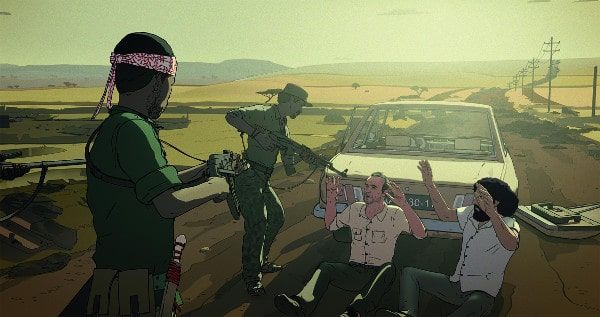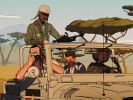Eye For Film >> Movies >> Another Day Of Life (2018) Film Review
Another Day Of Life
Reviewed by: Amber Wilkinson

Animation has been put to good documentary use lately, in films such as Waltz With Bashir - with which this film shares some DNA - and Tower. In Another Day Of Life, which relates a small portion of the horrors of the Angolan War, directors Raul De La Fuente and Damian Nenow take the idea a step further, blending the animated segments with actual footage of some of those involved, returning to the country and recalling what happened in the present day. These elements don't exist as separate regimented entities as they might in most films, but bleed into one another at surprising moments, generating heightened emotions, underlining chaos and acting as a constant reminder that these events are firmly rooted in truth.
Our window to the conflict is the very personal account of Polish journalist Ryszard Kapuscinski but it goes far beyond simply adapting his book of the same name as the film, plunging us not only into the physical warzone but also into the shifting, sometimes surreal psychological landscape of the writer. Beyond the more familiar considerations of the way that civil wars are no respecters of age or viewpoint when it comes to body count and the, by now all too familiar, concept of a proxy war, the film also touches on the very real impact that journalists can have - for good or ill - by simply by being present.

The year is 1975, and the storytelling concise. As the Portuguese colonial rule comes to an end, Angola because a "Cold War chessboard" with the US and Russia among others backing various factions. The motion-captured animated Kapuscinski (voiced by Kerry Shale) is drawn with a muscularity that matches his sense of determination to head to the south of the country to report on the action at the front and, in particular, to try to meet the Portuguese-turned-rebel-leader Farrusco (Youssef Kerkour). Everything in the country may be "confusao" but the directors have tight control of the subject matter, immersing us fully in Kapuscinski's world before taking us on his road trip with fellow journalist Artur (Daniel Flynn).
These early exchanges suffer a little from the gnomic way Kapuscinski tends to speak, as though he might have been a Dashiell Hammett detective in a previous life, with his "Welcome to my cage" patter - but this is no doubt partially due to the deliberate emulation of a graphic novel style, which will also see a heroine, Carlota (Lillie Flynn) emerge in due course. Just like many graphic novels, however, there's considerably more going on under the surface than first appears and by simplifying the nature of his character's representation, it allows the other elements of the story and, most importantly, those people who were the subject of his writings, to become the film's major focus.
Once Kapuscinski and Artur hit the road, the film notches up several gears as its hybrid nature comes into its own. Along the route they stumble upon the aftermath of a massacre, a situation that is viscerally recreated, not just by the sight of flies buzzing around dead bodies but, thanks to the flexibility of animation, by a sidestep into Kapuscinski's mind as he comes upon the horror. This ability to slip seamlessly into alternate psychological realities in the film gives it an emotional intensity. This on its own, would make for a powerful watch, but it is further reinforced by different but equally impassioned sense of contemplation by the inclusion of footage of Artur, Farrusco and others in the present day.
Their measured but naturally emotional recollections dovetail with the more impressionistic animated segments to scrutinise the psyche of war that finds echoes in the ongoing Syrian conflict among others. They also serve as a reminder of the long shadow of war - when Kapuscinski says, "When you've lived through war, you can never be free of it", it may sound like cliche, but as the survivor testimony shows, many cliches are rooted in truth.
Reviewed on: 21 Oct 2018















